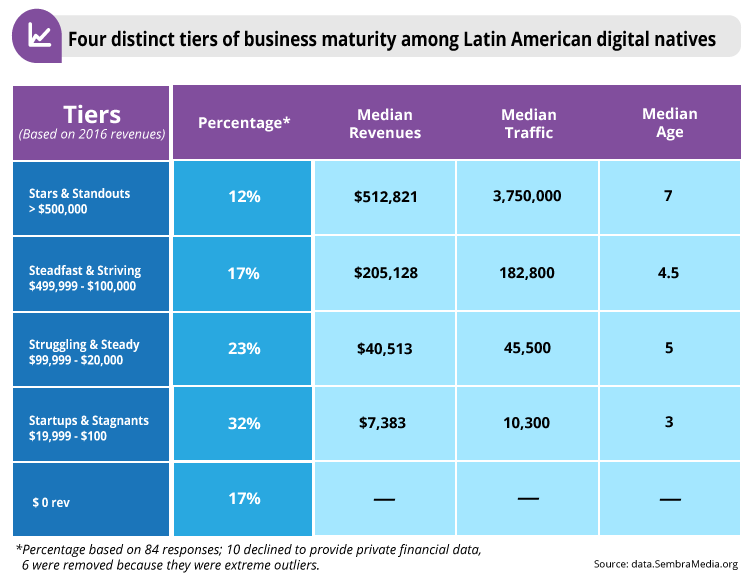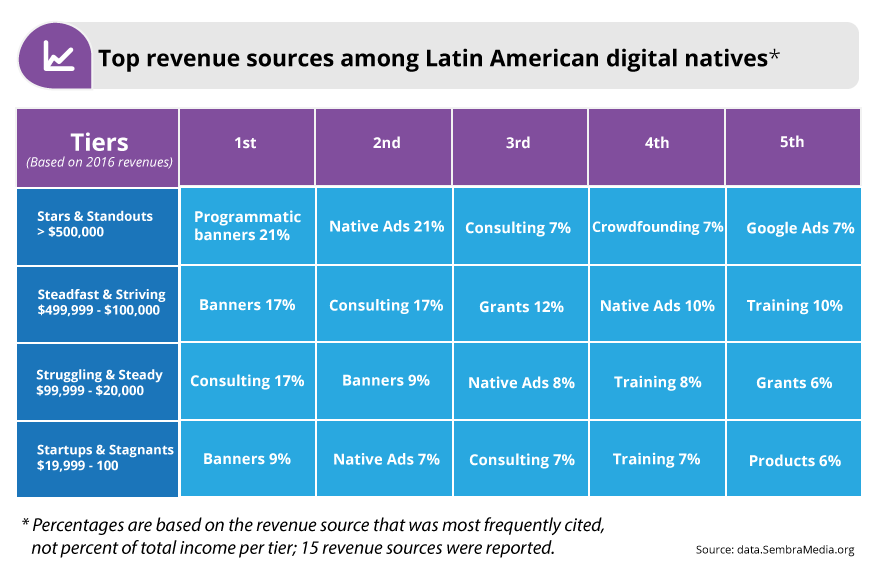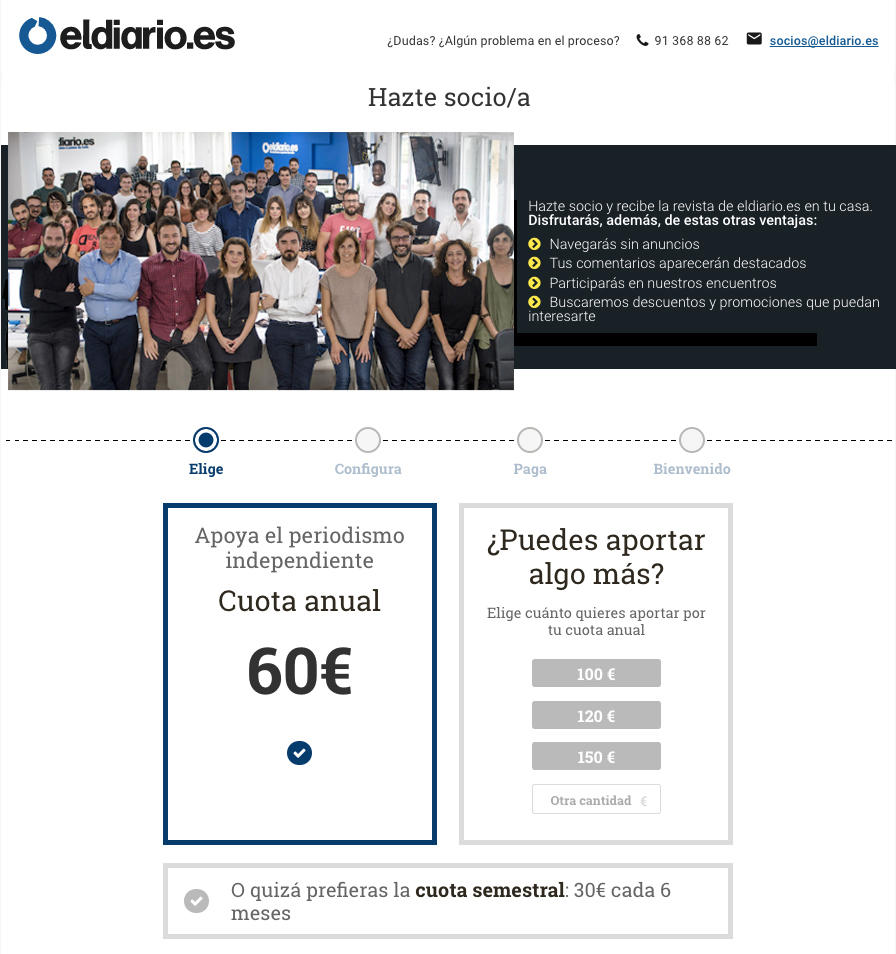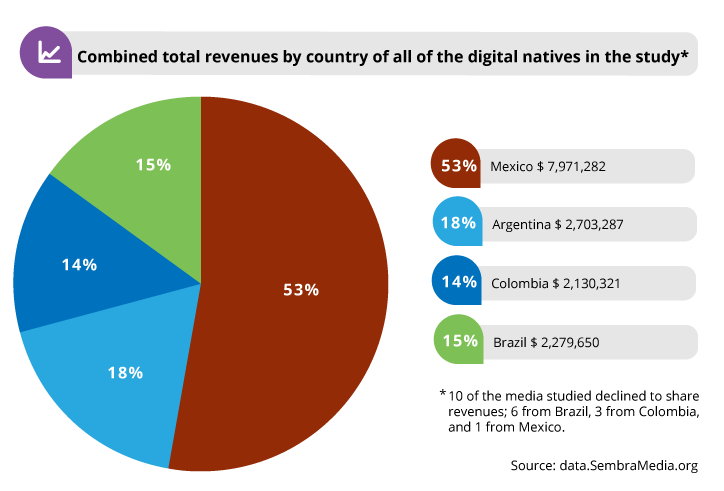BUSINESS MODELS
THE QUEST FOR SUSTAINABILITY
A growing number of digital natives in Latin America have developed sustainable— and even profitable — business models; and it doesn’t cost much to launch them. More than 70% started with less than $10,000, and more than 10% of those are now bringing in more than a half million dollars a year in revenues.
Diverse business models bring success
The number of digital natives in Latin America who are building sustainable businesses around quality journalism has grown dramatically since the first ventures in this study launched in 1998.
Despite the diversity in audience size, revenues, years in business, and the type of content they produce, across the board these entrepreneurs are optimistic about the future, and our research suggests they have reason to be.
Comparing reported revenues and expenses for 2016, nearly half of the digital natives in this study appear to be breaking even or showing at least a slight profit.
Overall, business expenses were roughly equivalent with revenues in most cases, although a few appear to be burning through startup capital as they attempt to build a sustainable business.
Among the 90 subjects that answered all our financial questions, 43 showed at least some profit; 47 showed some losses. Although confidentiality prevents us from revealing the propriety financial data of each venture studied, their total profits were $4 million, and their total losses were $1.4 million.
At the high end, advertising is the top revenue driver, and large audiences are key to their success.
In the mid ranges, diversified revenue sources, including consulting, training, and grants, make the difference when it comes to sustainability.
Broadly speaking, we found two paths to growing revenue: building audience to drive traffic and advertising, or leveraging the loyalty of your audience to earn revenue with crowdfunding, training, events, and other sources. These paths are not mutually exclusive.
10% of publishers declined to disclose private financial data
In all the other sections of this report, percentages were based on the 100 digital media natives interviewed. In this section on business, percentages were based on 90 responses because 10 of the publishers interviewed declined to share private financial data; 6 from Brazil, 3 from Colombia, 1 from Mexico.
Again, we found that the median was a better way to represent these findings, than the average.

Startup capital: Small investment can lead to big returns
One of the revelations of this study is that startup capital does not necessarily determine commercial success—71% of these ventures started with less than $10,000 in initial investment, usually from the founders themselves.
Of these, 9% had already gone on to bring in revenues of more than $500,000 in 2016.
While there is no statistical correlation between initial investment and revenues across all the ventures we studied, the median investment in the top tier was 80% higher than the lower tiers.
Still, the median, even at the top tier of revenues, was only $38,000 in initial investment, and the top revenue generators have reached well into the millions now.
This suggests that modest investment in a good idea with the right team can lead to profitable businesses for digital media in Latin America.
Categorizing digital natives into tiers reveals how revenue differs based on traffic and income sources
To better understand the emerging business models among the diverse digital natives in this study, we divided them into four distinct tiers and then analyzed the best sources of revenue at each tier, factoring in revenue sources, traffic levels, content mix, and the size of their sales team.
The decision to base the tiers on total revenues resulted from the strong mathematical correlation (.73) between size and revenue.
Despite the broad range of organizations in this study, when we divided them into four categories, common characteristics emerged.
Some of the most interesting insights were found in the middle tiers, where relatively minor investment could have the greatest impact.
At all four revenue tiers, these digital media publishers were optimistic about their future potential. The majority projected revenue growth of at least 30% in 2017. The most successful revenue generators were also the most optimistic. Many of them predicted 50% to 70% growth.

Top tier: Stars & Standouts
Diversification of revenues is widespread and key to sustainability, but for the top performers advertising is still king.
Most of the highest revenue generators, those who are bringing in $500,000 or more per year, are blending entertainment and political coverage to drive millions of visitors (the median was 3.7 million sessions per month).
Their main sources of revenue are advertising related and they demonstrate a sophisticated use of traffic monetization technologies, participating in programmatic display and native ad exchanges, and making use of revenue optimization and analytics platforms.
Bootstrapping is as important at the top of these tiers as the bottom. Four of the top earners in this category started with $5,000 or less in initial investment, three started with more than $70,000. Although there was one exception, these top earners had also been in business the longest, with a median age of 7 (nine of the 10 were more than 4 years old).
Second tier: Steadfast & Striving
In the second tier, where revenues range from $100,000 to $499,999, a more diversified revenue model emerges that combines banner ads with consulting, training, and grants.
The types of journalism being produced in this category varied widely, but general news and political coverage were the most common, with a smattering of culture, science, environmental, and human rights coverage.
Traffic numbers also varied, with some attracting millions of visitors, others hundreds of thousands, and a few less than 10,000 per month. Of note, the three ventures with the lowest traffic in this category were also the only ones to report grants as their top revenue source. All three were focused on covering underserved communities, reporting on corruption, and environmental issues.
Two of the digital natives in this second tier launched with no investment, one reported $8 in initial capital, which we assume was the cost of their domain name. Two launched with more than $150,000. All were financed out of the founders’ own pockets or with funds from family and friends.
Third tier: Struggling & Steady
In the third tier, where revenue ranges from $20,000 to $99,999, advertising revenue drops off significantly, and the mix changes to rely even more heavily on non-advertising related revenues, including consulting, training, grants, crowdfunding, and events.
Traffic to the sites in the third tier also drops off significantly with a median of only 45,000 sessions per month. This again supports the finding that traffic and revenues are strongly related.
There is no clear content focus in the third tier, but there were more journalists focused on human rights, environmental issues, indigenous populations, gender, and the LGBTQIA community.
Twelve started with less than $10,000 in initial investment; four started with more than $100,000, suggesting again that startup capital is not a determining factor in building revenues.
In this category, sources of revenue vary widely, but there are a few things that stand out. Among the top three revenue sources, 11 reported income from banners or native advertising, 12 reported consulting, nine were doing training, eight reported grants, four relied on government funding, four were making money on events, and three were burning through loans or investment.
Of the 22 ventures in this category, 18 report at least three different sources of revenue.
Four rely almost exclusively on grants. Again, these three had the lowest audience size and were focused on covering human rights, corruption, and underserved communities.
A striking finding in this third revenue tier, as well as the fourth, was that based on the median team size and structure, these ventures had no one focused on sales.
Fourth tier: Startups & Stagnants
One of the greatest strengths of the new media players in this study is that they were founded by entrepreneurs who are dedicated to producing quality journalism.
Yet the relentless focus on content often comes at the expense of business, and it’s especially evident in this bottom tier.
Most of these are very small organizations with a median size of six team members, dedicating 82% of their expenses to content production.
Revenue in the fourth tier was below $20,000 in 2016, but it’s important to note that some of the digital media in this tier were less than a year old at the time of this study, and a couple were already showing signs of growth in revenues and traffic by early 2017.
A few of the projects in this category were more than a decade old, and with reported revenues of less than $10,000, it’s clear their focus is content not profits.
The median age in this group is 2 years old, and the median income in 2016 was $7,400. Traffic numbers were also the lowest in this category and most had less than 10,000 sessions per month.
However, five had more than 100,000 sessions per month, which suggests some may be serving their audiences well, but have not figured out how to monetize them. All five would likely benefit quickly from even a modest investment and increased efforts in business development.
Revenue sources were all over the map, with a smattering of Google banner ads and local sponsors, combined with crowdfunding, products, and content syndication. Four rely almost exclusively on grants.

Six outliers removed
After reviewing these categories extensively, we decided to remove six outliers from the mix because they distorted the findings.
Three were removed because they only publish on social media platforms, which made their traffic numbers not comparable with those that publish on their own websites. Three others were removed because they had a single revenue source or business model not comparable with the others. Thus, these four tiers are based on only 84 respondents.

Diversifying revenue supports sustainability
Although advertising is the number one source of revenue for digital media natives, a growing list of more than 15 revenue opportunities is emerging, including training, consulting, grants, events, and crowdfunding.
More than 65 reported they had at least three sources of revenue. Only nine rely solely on one revenue category, a dozen reported only two sources of revenue.
Advertising is key, and it’s evolving rapidly
Across the study, there is a clear statistical correlation (.73) between traffic and revenues that seems to be driven by advertising.
Banner ads represent the number one source of revenue in the top two tiers of the digital natives we studied, but the types of ads vary wildly depending on the size of their audience.
In the top tier, 56% percent of revenue comes from advertising. The top three revenue generators all had traffic of more than 5 million sessions per month and were taking advantage of the latest trends in advertising, participating in programmatic ad exchanges and native advertising.
Reviewing the sites in the top revenue tier with the Ghostery service, revealed that most are using programmatic ad tags, and they are participating in as many as 23 different ad exchanges.
This finding is especially significant because it appears that the sites participating in ad exchanges are earning revenue from their U.S. traffic being sold to advertisers.
Traffic analysis of all of the sites in this study showed that they get the most of their traffic from their own countries, but the second highest source of traffic was from the U.S.
The programmatic ad exchanges (also called DSPs) most frequently detected with Ghostery, were: The Trade Desk, Oracle BlueKai, Turn Inc., MediaMath, OpenX, and AOL’s Advertising.com for Publishers.
When Ghostery was used to detect all of the ad-related tags (not just programmatic exchanges), the record was 89 ad tags being used by one of the top revenue-generating sites in this study.
Across the entire top tier, the median was 21 ad-related tags. In the second tier, four ad-related tags, and in the third, just two. This suggests that participating in more ad exchanges, optimizing pages for ad placement, and and driving audience acquisition, could add up to significant revenue gains.
Two outliers in the top revenue tier that were not participating in ad exchanges seemed to make up for it with grants, crowdfunding, or donations.
In the second tier, 32% get revenue from native advertising and traditional banners, but five also had programmatic ad tags.
Even in the lowest tier, the sites that had more than 100,000 sessions per month would likely benefit from participation in ad exchanges.
Native advertising brings opportunity and editorial challenges
Native advertising stands out as a significant source of revenue across all four levels of maturity.
Native advertising growth is being driven by a host of problems with banner ads — from click fraud to banner blindness to ad blockers. This new form of sponsored content is gaining popularity around the world and may provide one of the best opportunities for revenue growth in small and large sites.
Overall, 28% of the ventures studied reported native advertising as one of their top three sources of revenue. Unlike other sources of revenue, native advertising appeared as a key source of revenue in all four tiers. The most popular native ad exchange network detected with Ghostery was Taboola.
However, journalists are understandably cautious about sponsored content and many digital natives have refused to accept anything that even hints at advertorials.
After studying best practices in Latin America, as well as media in other parts of the world, our conclusion is that native advertising is increasingly important for financial success, but to preserve editorial integrity it must be governed by a carefully worded, and well-enforced policy that sets clear guidelines and puts limits on the type of advertising media accept.
One publication we interviewed that positions itself as a specialist in creating content tailored to individual brands is Enter.co of Colombia.
Enter.co focused on the “digital culture” of technology, entrepreneurship, and entertainment. In their well-designed media kit, they report more than 1 million users a month who spend 3 million minutes a month consuming the site’s content. (Citation: Enter.co media kit)
Alternatives to advertising
It is clear that developing a diversified revenue model is key to building a sustainable business while maintaining editorial independence. In this section, we explore in more detail some of the alternatives to advertising that are emerging as popular revenue sources among digital natives.
Donations offer promising revenue potential for mission-driven ventures
A small group of loyal, engaged users can produce a significant amount of revenue. And small donations from many people are proving one of the most robust income sources for journalists who seek independence.
When media organizations move from requiring subscriptions to offering membership, they change the dynamic from a contractual, economic relationship to an invitation for reader support. Despite the abundance of free news available online, readers around the world are paying for content, especially investigative journalism and other unique information that adds value to their daily lives and communities.
Because crowdfunding and audience donations only represented 15% of the top revenue sources reported, this category stands out as an area of potential growth for most of the ventures in this study. Although nascent in Latin America, this trend warrants attention because of the success we’ve seen at other media companies around the world.
National Public Radio in the United States was one of the first to demonstrate that small, regular donations provide a more reliable income source than annual fundraising campaigns.
One of the best examples of donor support in the Spanish-speaking world can be found in ElDiario.es in Spain. Although not included in our investigation, the success of this five-year-old digital news site warrants attention.
In the highly competitive media market of Madrid, ElDiario.es has distinguished itself by publishing daily news and conducting a series of hard-hitting investigative reports on corruption, and their readers have rewarded them handsomely for their efforts.
In 2016, the company generated €3.6 million euros in revenue, with nearly €1.2 million from “partners,” who donate at least €5 per month (many pay more).
It’s not a subscription model, the site is free, but donors receive two benefits: they can view the site without advertising, and instead of receiving the daily newsletter in the morning, they get it the night before.
Also of note, only a small segment of their audience are making regular contributions. Of the millions of visitors to their site, only 1% (about 20,000 people) are regular contributors, and 80 percent of them renew their memberships every year.
Many sites run annual crowdfunding campaigns to attract support from readers.
The Super Amigos program by La Silla Vacia has attracted $100,000 in support over the last several years, but even they report that the effort required may not be worth the return when done as an annual event.
Instead, more consistent income from recurring donations is proving a more reliable and sustainable model. After running multiple annual crowdfunding campaigns, Animal Político of Mexico started asking for monthly, ongoing donations, instead of one-time payments, during their 2017 campaign on the Mexican crowdfunding site Fundeadora.
Training brings more than just revenue
Training is not only a good long-term source of revenue, it builds credibility, attracts new audiences, deepens relationships, and makes readers more likely to become donors. As journalists train their audience members (and other journalists) they are also creating a starting point for recruitment, and participants often go on to become team members.
Across the entire study, 19% of the news organizations generate revenue by turning their skills into training, usually in the areas of journalism or technology skills.
For a website in Brazil, training is their business. Brio Hunter has developed a platform to provide a variety of online and in-person training and coaching for journalists. Brio Hunter demonstrates that a paid training model can work in Latin America, providing one of the most important sources of revenue journalists are using to support their projects.
In Argentina, Tiempo Patagónico provides training in meteorology and how to understand the wild swings in weather, which in the most southern tip of Argentina can mean life or death.
El Meme of Argentina invited users to join its network of content creators for its entertainment website, and has used its online training course to develop an extensive database of contributors. As the site grew, many of those contributors joined their staff.
Events deepen relationships, create loyalty and revenue
Getting face-to-face with users deepens trust and helps builds long-term relationships. While 24% of the organizations have hosted an event, only 9% listed events as one of their top three revenue sources.
Expanding media businesses to include events is a global trend. In the U.S., media as diverse as the New York Times and MinnPost are discovering that events offer a solid source of new revenue because they provide an opportunity to increase donations and sponsorships.
This trend extends to Latin America where events hosted by the digital natives in the region range from political debates to Halloween parties.
Clearly, this is another promising revenue growth area, one that may be even more crucial to the digital natives who serve niche audiences.
Events can help even small ventures to deepen the relationships they have with their audience, and provide face-to-face opportunities to seek donations.
Consulting brings much-needed revenue to smaller digital media sites
As we found with events and training, many journalists offer consulting services and use the funds to support their journalism projects.
Across the study, 28% listed consulting as one of their top three revenue sources, usually in the form of website design, social media management, or content creation.
Consulting was especially important in the two middle tiers, and seems to help make up for the lack of traffic needed for serious advertising revenue.
In many cases, the journalistic website serves as a kind of promotional device, attracting an audience of potential clients.
Grants provide revenue to a relatively small segment of these digital natives
Only 14 of the digital natives studied reported receiving grants as one of their top sources of revenue between January 1 and December 31, 2016.
In the top revenue tier, only one reported receiving grant funding. In the second tier, four reported grants as their top revenue source, in the third tier, five rely primarily on grant funding, and in the fourth tier, four received grants.
Ten of those 14 also reported receiving grants in previous years. The most commonly cited grant and philanthropic investment sources were the Open Society Foundations and the Ford Foundation. Other funding sources included: the European Union, Google, HacksLab, Hivos International, ICCO International, International Center for Journalists, Media Development Investment Fund, Omidyar Network, and Oxfam.
Primary sources of revenue
Banner ads 31%
Native ads or branded content 28%
Consulting services 28%
Training services 19%
Grants 16%
Content syndication 16%
Crowdfunding and donations 15%
Google AdSense 15%
Government ads or funding 12%
Events 9%
Product sales 8%
Programmatic ad exchanges 7%
Subscriptions or memberships 5%
Influencer sponsorship 5%
Percent of media studied that use each revenue type
Government advertising distorts the market, but among these digital natives it is not a top source of revenue
The enormous amount of money spent by governments on advertising distorts the ad markets in the countries we studied, especially in Mexico and Argentina.
The business and political interests that control public discourse use advertising to reward favorable coverage and withdraw support when criticized.
In this context, many independent media publishers find themselves at a significant disadvantage.
Some readers might be surprised by the seemingly low influence of government funding reported in this study, but that is almost undoubtedly due to the way the original sample was selected because media sites that were exclusively dependent on government advertising or other support were not included in this investigation.

Newsletters fuel donations
Media sites with successful donor programs report that a strong and well-managed email newsletter is the key to success.
Yet, 40% of those interviewed in our study said they don’t have a database of users, and most that did had less than 5,000 contacts. Even worse, when asked how many people they were sending newsletters to, the response rate dropped off drastically.
Email newsletters are a powerful tool for media trying to deepen a relationship with their communities because they give organizations a direct entry point into users’ daily digital habits. Newsletters are also great traffic drivers, which fuel advertising opportunities.
While this type of touchpoint with current and future readers can be time consuming to develop, email newsletters offer valuable marketing channels that can also open up and strengthen other revenue sources, such as events and training.
This problem could be relatively cheap and easy to fix with training thanks to off-the-shelf newsletter services, such as MailChimp.
Brazil’s Man Talk sparks a social media conversation
In Brazil, Papo de Homem (“Man Talk”) is a leader in native advertising, it charges clients to create “branded channels” with multimedia content on social media.
Their powerful participatory website focuses on conversations about men’s issues, attracting 2 million monthly users, as well as 500,000 fans on Facebook, 63,000 followers on YouTube, 52,000 on Twitter, and 37,000 on Instagram.
Their media kit boasts that in their 10 years of existence, 800 writers have contributed 5,000 articles.
They also offer training for people who want to write for the site. Papo de Homem’s success suggests that creating a community around niche and targeted content can not only build credibility and a significant audience, it can help attract advertisers.
Case study: Costume party proves a playful fundraiser
Nómada of Guatemala provides a delightful example of how events can be both a source of revenue — and fun.
In the fall of 2016, the Guatemalan news startup hosted a Halloween party and encouraged their millennial audience to attend in costume. To promote the event, they created an engaging video, shot guerilla style with cast members wearing costumes in an industrial landscape, and even on a train.
The event was not only a playful way to engage their audience, it was an excellent way to bring fresh exposure to one of their biggest sponsors: Huawei Technologies, a Chinese multinational telecommunications equipment and services company. Although not included in this study, Nómada is one of the leading sites in Central America and also provides a great example of how to tell the story of a small site in a media kit.
Fact-checking news service
Agência Lupa of Brazil may have invented a new kind of news service, a fact-checking news wire.
It has done work for some of the biggest media outlets in the country, including this fact-check of President Michel Temer’s government done with Folha de S. Paulo.
It counts among its other clients the CBN radio network, GloboNews, and Época Magazine.
They also collaborated with Univision on the presidential debates of Hillary Clinton and Donald Trump.

Comparing digital natives in four media markets
Although the economic conditions of each of the four countries in this study vary significantly, the trends we found when we compared staffing levels, traffic, and revenue sources, were remarkably consistent across all four.
All four revenue tiers included media from all four countries.
The importance of revenue diversity was consistent in all four, and we identified media in Mexico, Argentina, and Brazil using programmatic advertising exchanges.
Among country-specific findings, Mexico stands out as the clear leader when it comes to making money with 53% of the total revenues reported.
Mexico was also the market where we found the highest use of programmatic ad exchanges and native advertising.
In keeping with the relative size of their markets, Brazil and Mexico had the highest levels of initial investment.
Mexico and Argentina reported the highest amount of traffic coming from mobile devices.
Colombia had the oldest digital media sites in the study; 76% had been publishing for more than four years.

